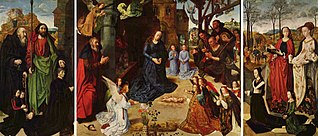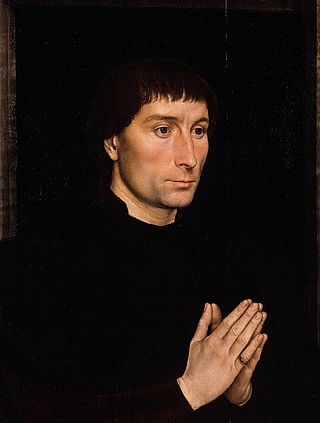
Paolo Uccello, born Paolo di Dono, was an Italian painter and mathematician who was notable for his pioneering work on visual perspective in art. In his book Lives of the Most Excellent Painters, Sculptors, and Architects, Giorgio Vasari wrote that Uccello was obsessed by his interest in perspective and would stay up all night in his study trying to grasp the exact vanishing point. While his contemporaries used perspective to narrate different or succeeding stories, Uccello used perspective to create a feeling of depth in his paintings. His best known works are the three paintings representing the battle of San Romano, which were wrongly entitled the Battle of Sant'Egidio of 1416 for a long period of time.

Domenico Veneziano was an Italian painter of the early Renaissance, active mostly in Perugia and Tuscany.

Andrea del Castagno or Andrea di Bartolo di Bargilla was an Italian painter from Florence, influenced chiefly by Masaccio and Giotto di Bondone. His works include frescoes in Sant'Apollonia in Florence and the painted equestrian monument of Niccolò da Tolentino (1456) in the Cathedral in Florence. He in turn influenced the Ferrarese school of Cosmè Tura, Francesco del Cossa and Ercole de' Roberti.

Lorenzo di Pietro, known as Vecchietta, was an Italian Sienese School painter, sculptor, goldsmith, and architect of the Renaissance. He is among the artists profiled in Vasari's Le Vite delle più eccellenti pittori, scultori, ed architettori.

Fabriano is a town and comune of Ancona province in the Italian region of the Marche, at 325 metres (1,066 ft) above sea level. It lies in the Esino valley 44 kilometres (27 mi) upstream and southwest of Jesi; and 15 kilometres (9 mi) east-northeast of Fossato di Vico and 36 kilometres (22 mi) east of Gubbio. Its location on the main highway and rail line from Umbria to the Adriatic make it a mid-sized regional center in the Apennines. Fabriano is the headquarters of the giant appliance maker Indesit.

Benozzo Gozzoli was an Italian Renaissance painter from Florence. A pupil of Fra Angelico, Gozzoli is best known for a series of murals in the Magi Chapel of the Palazzo Medici-Riccardi, depicting festive, vibrant processions with fine attention to detail and a pronounced International Gothic influence. The chapel's fresco cycle reveals a new Renaissance interest in nature with its realistic depiction of landscapes and vivid human portraits. Gozzoli is considered one of the most prolific fresco painters of his generation. While he was mainly active in Tuscany, he also worked in Umbria and Rome.

The Portinari Altarpiece or Portinari Triptych is an oil on wood triptych painting by the Flemish painter Hugo van der Goes, commissioned by Tommaso Portinari, representing the Adoration of the Shepherds. It measures 253 x 304 cm, and is now in the Galleria degli Uffizi in Florence, Italy. This altarpiece is filled with figures and religious symbols. Of all the late fifteenth century Flemish artworks, this painting is said to be the most studied.

Giovanni Lanfranco was an Italian painter of the Baroque period.

The National Roman Museum is a museum, with several branches in separate buildings throughout the city of Rome, Italy. It shows exhibits from the pre- and early history of Rome, with a focus on archaeological findings from the period of Ancient Rome.
Giovanni Balducci, called Il Cosci after his maternal uncle, was an Italian mannerist painter.

Neri di Bicci (1419–1491) was an Italian painter active in his native Florence. A prolific painter of mainly religious themes, he studied under his father, Bicci di Lorenzo, who had in turn studied under his father, Lorenzo di Bicci. The three thus formed a lineage of great painters that began with Neri's grandfather.

The Sassetti Chapel is a chapel in the basilica of Santa Trinita in Florence, Italy. It is especially notable for its frescoes of the Stories of St. Francis, considered Domenico Ghirlandaio's masterwork.

Bicci di Lorenzo (1373–1452) was an Italian painter and sculptor, active in Florence.

Paolo Mascagni was an Italian physician and anatomist. He is most well known for publishing the first complete description of the lymphatic system.

Ospedale del Ceppo is a medieval hospital founded in 1277 in Pistoia, Tuscany, central Italy.

Folco Portinari was an Italian banker and several times the prior of Florence. He was the father of Beatrice Portinari, the woman largely identified as the character loved by Dante Alighieri and mentioned in his works.

The Hospital of the Holy Spirit is the oldest hospital in Europe, located in Rome, Italy. It now serves as a convention center. The complex lies in rione Borgo, east of Vatican City and next to the modern Ospedale di Santo Spirito. The hospital was established on the site of the former Schola Saxonum, a part of the complex houses of the Museo Storico.

Andrea di Giusto, rarely also known as Andrea Manzini or Andrea di Giusto Manzini was a Florentine painter of the late Gothic to early Renaissance style in Florence and its surrounding countryside. Andrea was heavily influenced by masters Lorenzo Monaco, Bicci di Lorenzo, Masaccio, and Fra Angelico, and tended to mix and match the motifs and techniques of these artists in his own work. Andrea was an eclectic painter and is considered a minor master of Florentine early Renaissance art. Andrea trained under Bicci di Lorenzo as a Garzone. He painted his most significant works, three altarpieces, in the Florentine contado, or countryside; these altarpieces were created for Sant’Andrea a Ripalta in Figline, Santa Margarita in Cortona, and the Badia degli Olivetani di San Bartolomeo alle Sacce near Prato. Aside from his major altarpieces, Andrea painted several Frescoes over the course of his career. He, along with other minor masters, are also known to have provided several different types of art, including triptychs and frescoes, for Romanesque pievi, or rural churches with baptistries. Moreover, he was well known for several types of smaller craft objects, such as small tabernacles. He is said to have worked between 1420 and 1424 under Bicci di Lorenzo on paintings for Santa Maria Nuova. He is said to have worked with Masaccio in painting the Life of San Giuliano for the Polyptych of Pisa, including the painting of the Madonna and Child, in 1426. He also appears to have collaborated in 1445 with Paolo Uccello in the Capella dell'Assunta in the Prato Cathedral. In 1428, he is listed as a member of the Arte dei Medici e Speziali guild in Florence as "Andrea di Giusto di Giovanni Bugli". His son, Giusto d'Andrea, was also a painter and worked with Neri di Bicci and Benozzo Gozzoli. Andrea died in Florence in 1450.

Portrait of Tommaso Portinari by Hans Memling is held by the Metropolitan Museum of Art, New York City. It was made c.1470 in oil on oak panel, and measures 44.1 by 33.7 centimetres. The painting and Memling's Portrait of Maria Portinari form the wings from a since dismantled triptych; the central panel is believed to have been a now lost depiction of the Madonna and Child; perhaps Memling's Virgin and Child in the National Gallery, London.

The Benedetto Portinari Triptych is a group of three 1487 oil on panel paintings by Hans Memling. It is named after its commissioner, who is probably the subject of its right-hand panel, now in the Uffizi in Florence. The left panel of Saint Benedict and the central panel of the Madonna and Child are both now in the Gemäldegalerie, Berlin. All three panels are set within a single loggia, with a unified landscape background across all three, which proved a major influence on Umbrian painters, Perugino and Leonardo da Vinci.
























